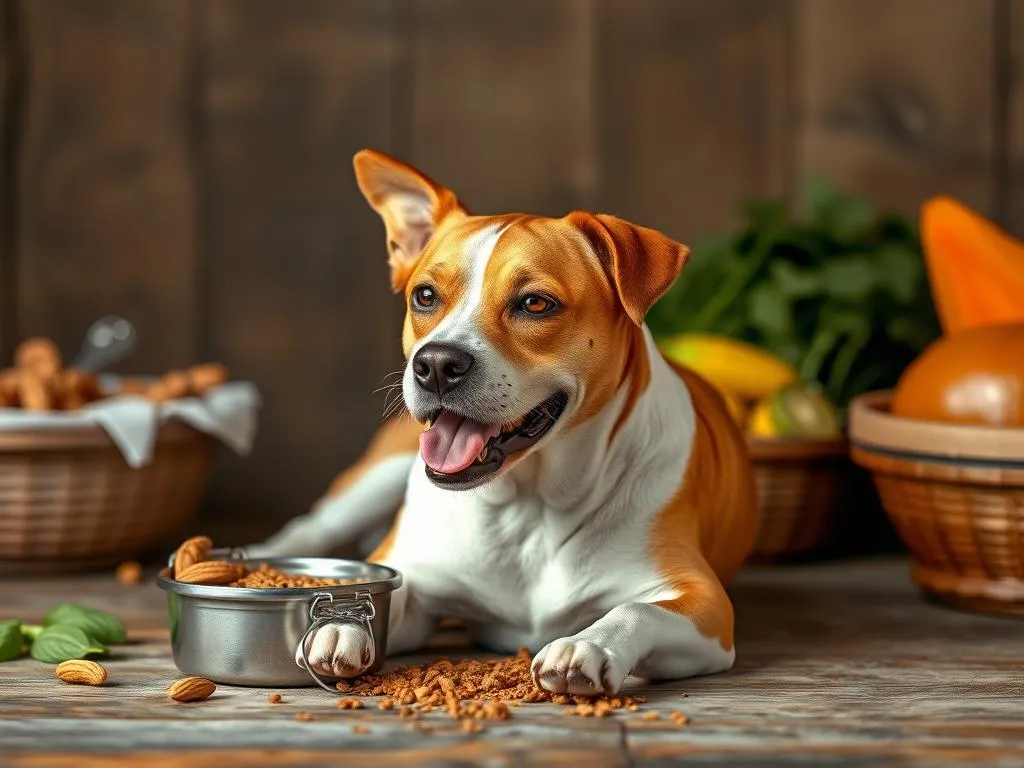
Proper dog nutrition is crucial for maintaining your furry friend’s health and well-being. Many dog owners may not realize that some dogs can develop allergies or sensitivities to certain ingredients, including chicken, which is a common protein source in many dog foods. This article will delve into the best chicken free dog foods, exploring why chicken-free diets are necessary for some dogs, the essential nutrients they need, and a variety of options available in the market.
Understanding Dog Nutrition
The Basics of Canine Nutrition
A balanced diet is foundational to a dog’s overall health. Dogs require various essential nutrients, including:
- Proteins: Vital for muscle development and repair.
- Fats: Provide energy and support cellular function.
- Carbohydrates: Serve as a primary energy source.
- Vitamins and Minerals: Important for bodily functions and overall health.
Each nutrient plays a unique role, and their balance is essential for optimal health.
Common Ingredients in Dog Food
Standard dog food often contains a mix of ingredients, including meat sources like chicken, grains, vegetables, and supplements. While chicken is a popular ingredient due to its high protein content, it can pose problems for dogs with specific dietary needs. Understanding these common ingredients is key to making informed choices about your dog’s nutrition.
Reasons for Choosing Chicken-Free Dog Food
Allergies and Sensitivities
Many dogs suffer from food allergies or sensitivities, with chicken being a common allergen. Signs of food allergies can include:
- Itchy skin
- Digestive issues
- Ear infections
- Chronic paw licking
If you notice any of these symptoms, it may be time to consider a chicken-free diet. Other common allergens include beef, dairy, wheat, and soy, so it’s essential to monitor your dog’s reaction to different ingredients.
Preference and Dietary Restrictions
Some dog owners opt for chicken-free diets for personal or ethical reasons. This includes preferences for vegetarian or vegan diets or concerns about the treatment of animals in the meat industry. Choosing a chicken-free option can align with these values while still providing balanced nutrition for your pet.
Key Nutritional Considerations for Chicken-Free Diets
Protein Sources
When selecting chicken-free dog foods, it’s crucial to ensure that your dog still receives adequate protein. Alternative protein sources include:
- Beef: Rich in iron and other essential nutrients.
- Fish: Provides omega-3 fatty acids, beneficial for skin and coat health.
- Lamb: A novel protein source, often suitable for dogs with allergies.
- Plant-based proteins: Such as lentils, chickpeas, and peas, which can provide essential amino acids.
Essential Fatty Acids
Fatty acids, particularly omega-3 and omega-6, are essential for a dog’s skin and coat health, as well as cognitive function. Recommended sources for chicken-free diets can include:
- Fish oil
- Flaxseed oil
- Sunflower oil
Carbohydrates and Fiber
Carbohydrates are an important energy source, and fiber helps maintain digestive health. When selecting chicken-free dog food, look for wholesome sources of carbohydrates, such as:
- Brown rice
- Sweet potatoes
- Oats
Fiber-rich ingredients, like pumpkin and peas, can also support healthy digestion.
Vitamins and Minerals
A balanced diet should include essential vitamins and minerals. Ensure that chicken-free dog foods contain the following:
- Vitamin A: Important for vision and immune function.
- B Vitamins: Support metabolism and energy production.
- Calcium and Phosphorus: Essential for healthy bones and teeth.
If a commercial food lacks certain nutrients, supplementation may be necessary.
Top Chicken-Free Dog Foods in 2023
Criteria for Selecting the Best Dog Foods
When choosing the best chicken free dog foods, consider the following factors:
- Ingredients: Look for quality, whole-food ingredients.
- Nutritional Value: Ensure it meets AAFCO standards for complete and balanced nutrition.
- Brand Reputation: Research the brand’s history and customer reviews.
Recommended Chicken-Free Dog Food Brands
Here are some top brands offering chicken-free dog foods in 2023:
1. Blue Buffalo Life Protection Formula
- Features: Made with real meat (like lamb or fish) as the first ingredient. Contains whole grains and fruits.
- Pros: High-quality ingredients, no artificial preservatives.
- Cons: Premium pricing.
- Price Range: $50-$70 for a 30-pound bag.
2. Wellness CORE Grain-Free
- Features: High-protein, grain-free formula with real meat and no fillers.
- Pros: Rich in omega fatty acids and antioxidants.
- Cons: Some dogs may require gradual transition.
- Price Range: $60-$80 for a 26-pound bag.
3. Merrick Grain-Free Texas Beef and Sweet Potato Recipe
- Features: Beef is the primary ingredient, complemented by sweet potatoes for fiber.
- Pros: High protein and quality ingredients.
- Cons: Rich formula may not suit all dogs.
- Price Range: $55-$75 for a 25-pound bag.
4. Taste of the Wild High Prairie Canine Recipe
- Features: Roasted bison and roasted roasted venison are primary proteins, with sweet potatoes and peas.
- Pros: Unique protein sources, grain-free.
- Cons: Some dogs may prefer a more familiar taste.
- Price Range: $50-$70 for a 28-pound bag.
Comparison Table of Chicken-Free Dog Foods
| Brand | Main Protein Source | Grain-Free | Price Range |
|---|---|---|---|
| Blue Buffalo Life Protection Formula | Lamb/Fish | No | $50-$70 |
| Wellness CORE Grain-Free | Various | Yes | $60-$80 |
| Merrick Grain-Free Texas Beef | Beef | Yes | $55-$75 |
| Taste of the Wild | Bison/Venison | Yes | $50-$70 |
Homemade Chicken-Free Dog Food Recipes
Benefits of Homemade Dog Food
Making your own dog food has several benefits, including:
- Customization: Tailor recipes to your dog’s specific dietary needs.
- Quality Control: Choose high-quality, fresh ingredients.
- Cost-Effectiveness: Often more affordable than commercial dog food.
Simple Chicken-Free Recipes
1. Beef and Sweet Potato Stew
- Ingredients: 1 lb ground beef, 2 sweet potatoes (diced), 1 cup carrots (diced), 2 cups spinach, 4 cups water.
- Preparation: In a large pot, brown the beef. Add sweet potatoes, carrots, and water. Simmer until vegetables are soft. Stir in spinach until wilted.
- Nutritional Analysis: High in protein and fiber.
2. Fish and Quinoa Bowl
- Ingredients: 1 lb salmon, 1 cup quinoa, 2 cups broccoli (steamed), 1 tbsp olive oil.
- Preparation: Cook quinoa according to package instructions. Bake salmon and flake it into pieces. Mix all ingredients together.
- Nutritional Analysis: Rich in omega-3s and complete proteins.
3. Lentil and Vegetable Medley
- Ingredients: 1 cup lentils, 2 cups mixed vegetables (carrots, peas, green beans), 4 cups vegetable broth.
- Preparation: Cook lentils in broth until soft. Add mixed vegetables and cook until tender.
- Nutritional Analysis: High in fiber and plant-based protein.
Transitioning Your Dog to a Chicken-Free Diet
Signs Your Dog Needs a Diet Change
If your dog exhibits symptoms such as itching, digestive upset, or a lack of energy, it may indicate a need for a dietary change. Consulting with a veterinarian can provide insights into whether a chicken-free diet is suitable.
How to Transition Safely
Transitioning your dog to a chicken-free diet should be gradual to avoid digestive issues. Follow these steps:
- Introduce the New Food: Start by mixing a small amount of the new chicken-free food with your dog’s current food.
- Gradually Increase the Ratio: Over the course of 7-10 days, gradually increase the proportion of the new food while decreasing the old food.
- Monitor Your Dog’s Reaction: Keep an eye on your dog’s digestion and overall health during the transition.
Conclusion
Selecting the right dog food is vital for your pet’s health, particularly when considering a chicken-free diet. It’s essential to consult with a veterinarian to ensure your dog receives all the necessary nutrients. With the variety of best chicken free dog foods available and the option to create homemade meals, you can provide your furry friend with the nutrition they need to thrive.









